Trees Birds Mammals Fish Amphibians Reptiles
Wild Algarve
Bookshop
Mollisia cinerea (Batsch) P. Karst. - Common Grey Disco
Phylum: Ascomycota - Class: Leotiomycetes - Order: Helotiales - Family: Dermateaceae
Distribution - Taxonomic History - Etymology - Identification - Culinary Notes - Reference Sources
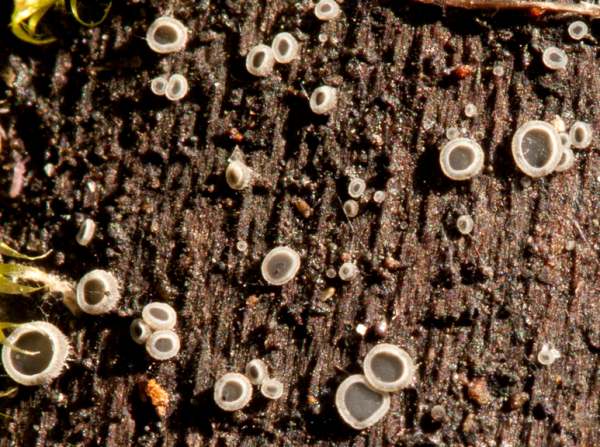
Mollisia cinerea, the Common Grey Disco, is
a wood-rotting cup fungus most frequently found on dead hardwood, but also occasionally on conifers..
Distribution
A common find in Britain and Ireland so gregarious that it is not easily overlooked despite its diminutive size, the Common Grey Disco Mollisia cinerea occurs also throughout mainland Europe, from Scandinavia right down to the southern shores of the Iberian Peninsula.
This fungus species has also been recorded in Asia, North America and southern parts of Australia.
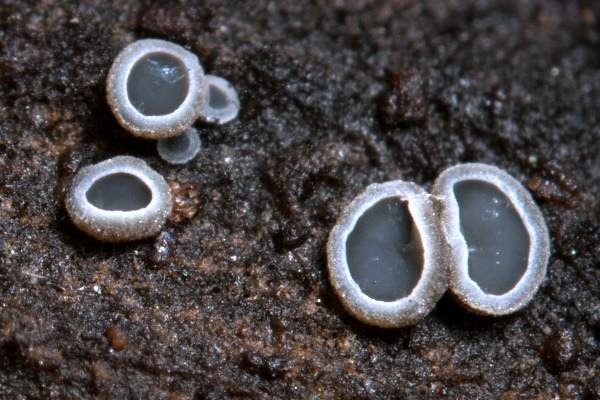
Taxonomic history
In 1786 when German botanist-mycologist August Johann Georg Karl Batsch (1761 -1802) described this species he named it Peziza cinerea. It was the Finnish mycologist Petter Adolf Karsten (1834 - 1917) who, in 1871, transferred this ascomycete fungus to its present genus thereby establishing its currently-accepted scientific name Mollisia cinerea.
Synonyms of Mollisia cinerea include Peziza cinerea Batsch, and Tremella cinerea (Batsch) Relhan.
Mollisia cinerea is the type species of its genus.
Etymology
The genus name Mollisia means soft or weak (spongy, not hard), while the specific epithet cinerea means grey - the fruitbody colour.
Identification guide
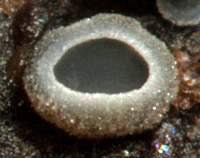 |
Narrowly-attached to the substrate, these stemless saucer-shaped (when fully developed) cup fungi are grey with a white margin. The cups are initially round but tend to become oval or kidney shaped, generally reaching no more than 1 to 2.5mm across.
The grey inner (fertile) surface where the spores develop within asci is smooth, while the grey-brown outer (infertile) surface is slightly scurfy |
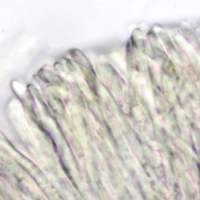 |
Asci
Cylindrical, 40-65 x 4-5.5µm; eight spores per ascus.
Paraphyses (pictured here)
Narrowly cylindrical, 2.5 to 4µm in diameter.
|
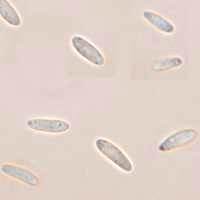 |
Spores
Fusiform, 7-12 x 2.5-3µm; with an oil drop at each end.
Spore print
White.
|
Odour/taste |
Not distinctive. |
Habitat & Ecological role |
Saprobic, on dead hardwood, particularly beech, birch and hazel. |
Season |
All year through except during hard frosts. |
Similar species |
Sarcoscypha austriaca, the Scarlet Elf Cup, is bright red
and grows on dead twigs and branches, in mossy woods and sometimes under damp hedgerows. |
Culinary Notes
Toxicity uncertain, but these cup fungi are far too small to be of any culinary interest.
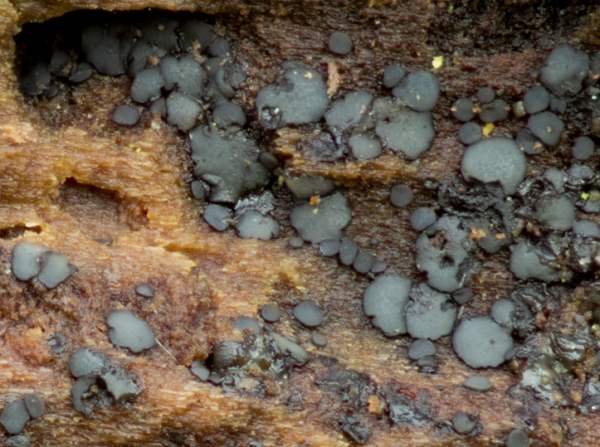
Reference Sources
Fascinated by Fungi, 2nd Edition, Pat O'Reilly 2016, reprinted by Coch-y-bonddu Books in 2022.
Dennis, R.W.G. (1981). British Ascomycetes; Lubrecht & Cramer; ISBN: 3768205525.
Breitenbach, J. & Kränzlin, F. (1984). Fungi of Switzerland. Volume 1: Ascomycetes. Verlag Mykologia: Luzern, Switzerland.
Medardi, G. (2006). Ascomiceti d'Italia. Centro Studi Micologici: Trento.
Dictionary of the Fungi; Paul M. Kirk, Paul F. Cannon, David W. Minter and J. A. Stalpers; CABI, 2008
BMS List of English Names for Fungi
Taxonomic history and synonym information on these pages is drawn from many sources but in particular from the British Mycological Society's GB Checklist of Fungi.
Acknowledgements
This page includes pictures kindly contributed by David Kelly.
Top of page...
Fascinated by Fungi. Back by popular demand, Pat O'Reilly's best-selling 450-page hardback book is available now. The latest second edition was republished with a sparkling new cover design in September 2022 by Coch-y-Bonddu Books. Full details and copies are available from the publisher's online bookshop...